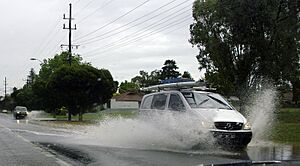Hydroplaning (tires) facts for kids
Hydroplaning (also called aquaplaning) is when a car's tires lose their grip on a wet road. This happens because a layer of water builds up between the tires and the road surface. When this occurs, the driver loses control of the vehicle. The car might not respond to steering, braking, or accelerating.
Contents
What Is Hydroplaning?
Hydroplaning means your vehicle is sliding on water instead of driving on the road. It's like a water skier gliding on water. For a car, this is very dangerous. Tires need to touch the road to steer and stop safely.
How Tires Lose Grip on Wet Roads
Normally, car tires have special grooves called treads. These treads help push water away from the tire. This allows the rubber to stay in contact with the road. When it rains heavily, too much water can build up. The treads cannot clear the water fast enough.
A thin layer of water then gets trapped under the tire. This creates a "wedge" of water. The tire lifts slightly off the road. When this happens, the tire loses its traction. Traction is the grip or friction between the tire and the road. Without traction, the driver cannot control the car.
Why Hydroplaning Is Dangerous
When a vehicle hydroplanes, it becomes very hard to control. You might try to steer, but the car goes straight. You might press the brake, but the car keeps sliding. This can lead to serious accidents.
Loss of Vehicle Control
- Steering: The steering wheel might feel very light. Turning the wheel will not change the car's direction.
- Braking: Pressing the brakes will not slow the car down effectively. The wheels might lock up and slide.
- Accelerating: Pressing the gas pedal might make the engine rev loudly. But the car will not speed up. Instead, the wheels might just spin on the water.
The danger depends on which wheels lose traction. If only the front wheels hydroplane, you cannot steer. If only the rear wheels hydroplane, the back of the car might slide sideways. This can cause the car to spin.
Factors That Cause Hydroplaning
Several things can make hydroplaning more likely. Understanding these factors helps drivers stay safe.
Vehicle Speed and Water Depth
Driving faster increases the risk of hydroplaning. At higher speeds, tires have less time to push water away. This makes it easier for water to build up under them. Even a small amount of water can be dangerous at high speeds. Deeper water also increases the risk. Puddles or standing water are especially risky.
Tire Condition and Road Surface
The condition of your tires is very important.
- Tread Depth: Tires with worn-out treads cannot clear water well. New tires with deep treads are much safer on wet roads.
- Tire Pressure: Properly inflated tires help maintain good contact with the road. Under-inflated tires can increase the risk.
The road surface also plays a role. Smooth roads or roads with ruts (grooves worn by tires) can collect water. This makes hydroplaning more likely.
How to Prevent Hydroplaning
Preventing hydroplaning is about safe driving habits in wet weather.
Safe Driving Tips in Rain
- Slow Down: Reduce your speed significantly when it's raining. This gives your tires more time to push water away.
- Check Tires: Make sure your tires have good tread depth. Check your tire pressure regularly.
- Avoid Puddles: Try to avoid driving through large puddles or standing water.
- Increase Following Distance: Leave more space between your car and the car in front. This gives you more time to react.
- Use Wipers: Keep your windshield wipers in good condition. Use them to maintain clear visibility.
What to Do If Your Car Hydroplanes
If your car starts to hydroplane, it can be scary. But knowing what to do can help you regain control.
Regaining Control of Your Vehicle
- Stay Calm: Do not panic. Keep a firm but relaxed grip on the steering wheel.
- Ease Off the Gas: Gently lift your foot from the accelerator pedal. Do not brake suddenly.
- Steer Straight: Keep the steering wheel pointed straight ahead. Avoid sudden steering movements.
- Wait for Traction: The car will eventually slow down. The tires will then regain contact with the road. You will feel the steering become heavier again.
- Gentle Corrections: Once you feel traction return, you can make small, gentle steering corrections if needed.
Remember, the key is to avoid sudden actions. Let the car slow down naturally until the tires can grip the road again.
Images for kids
See also
 In Spanish: Aquaplaning para niños
In Spanish: Aquaplaning para niños



